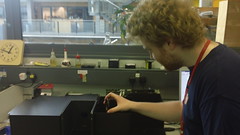Team:Imperial College London/Reporters
From 2011.igem.org
| Line 10: | Line 10: | ||
<p style="text-align:center;"><iframe width="560" height="315" src="http://www.youtube.com/embed/dEyfjhkS-gQ?rel=0" frameborder="0" allowfullscreen></iframe></p> | <p style="text-align:center;"><iframe width="560" height="315" src="http://www.youtube.com/embed/dEyfjhkS-gQ?rel=0" frameborder="0" allowfullscreen></iframe></p> | ||
| - | |||
| - | |||
<br> | <br> | ||
Revision as of 23:20, 19 September 2011
Fluorescent Reporters
Dendra2
Dendra2 is the first photoconvertible protein that has been introduced into the registry. When excited with a certain wavelength of light, the protein is permanently converted from green to red. This interesting property allows it to be used for any processes that looks at production. In our experiments, we planned to use Dendra2 in order to monitor the metabolic viability of our Escherichia coli once it was in the root.

Fig. 1: Predicted developmental stages of the AuxIn project. Source of biology, toxicology, and environment data: CropLife International, as supplied by Dr Stuart Dunbar.
Many other exciting applications such as more accurate promoter characterisation will be possible since one would be able to photoconvert all of the Dendra2 and then measure the synthesis rate from point zero at different OD's. We would have loved to flesh out this new characterization method but sadly ran out of time. However, we were able to get many interesting results.
First we tested the photoconvertability of the Dendra2. In order to do that we used a FluoroMax-3 machine. Luckily, Tim Wilson was kind enough to help us set up the fluorometer in order to perform our experiments. We found that Dendra2 will fluoresce red upon conversion by light at a wavelength of 405 nm very quickly.

Fig. 1: Predicted developmental stages of the AuxIn project. Source of biology, toxicology, and environment data: CropLife International, as supplied by Dr Stuart Dunbar.
Thermostability assay
Fluorescent reporters are an important tool in molecular biology, as they are frequently used to label various intracellular processes. In synthetic biology, fluorescent reporters are often used as the output of a genetic circuit, for example to signal the detection of a chemical.
As part of our iGEM project, we implemented a new fluorescent reporter, Dendra 2. In addition, we introduced a new coding sequence for superfolder GFP (sfGFP) that is codon-optimised for E. coli. These were both used as part of our imaging experiments of bacteria inside plant roots. sfGFP was also used in our soil experiments to label our bacteria so that we could later identify them.
sfGFP and mRFP were also used in our assembly strategy for the Gene Guard module. sfGFP was part of the construct of our CRIM plasmid, and would be used as a reporter to evaluate the level of expression of anti-holin. mRFP formed part of the plasmid construct of the Gene Guard and this would be used to measure the expression of holin and endolysin. The mRFP would also be used to track the transmission of the plasmid in subsequent conjugation assays that would be carried out to test the effectiveness of the Gene Guard.
Since we ended up working with so many fluorescent reporters during our project, we decided to further characterize these important BioBricks. An important characteristic that has been omitted from the registry page is the thermostability of these proteins. This is an important aspect when choosing a fluorescent protein for a thermophile.
< "
"




